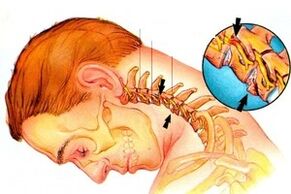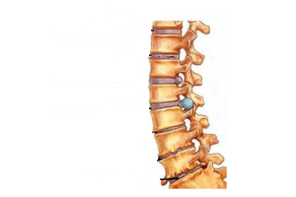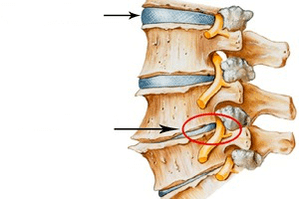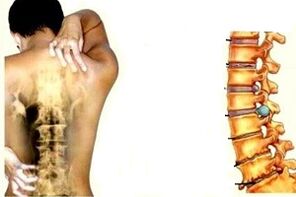
Musculoskeletal system diseases are one of the most common diseases on earth.Few people can avoid them completely, especially after 40 years, although experts admit that problems with the spine, muscles and joints have "younger", and young people are increasingly complaining about pain.
This is the fault of this is the way of life, which has already become familiar to many: inactivity, prolonged stay in one position (most of the time behind gadgets and monitors), lack of physical activity.As a result, the posture is disturbed, salts and other harmful substances accumulate in the body, the functions of the musculoskeletal system are impaired and, as a result, the internal organs may be deformed.
Most of the time, osteochondrosis is found in these diseases, to which people are subject to older and very young age and among the problems of osteochondrosis with the spine and cervical.The second most frequent, cervical type of osteochondrosis is an unpleasant disease and, moreover, progressive, without treatment, a lifestyle significantly worsening disability.This means that it is necessary to recognize the symptoms of this disease in a timely manner and, over time, contact an orthopedist or a vertebrologist for treatment.
How cervical osteochondrosis develops
If a person leads a sedentary lifestyle or, by virtue of his profession, is in the same position for a long time, the risk of getting osteochondrosis is very high.With the development of the disease, changes occur in the intervertebral discs, they are deformed and their structure changes.
The intervertebral discs are located between the vertebrae, their function is to support the spine, make it flexible and strong.There are seven vertebrae in the neck, with the help of which the head is supported and rotated, the neck is folded and so on.Cervical vertebrae are located very close to each other, so they are injured and displaced even with small physical efforts.The danger of the disease lies in the fact that it affects the nerve endings of the spinal nerves, which damages the vessels that provide blood to the brain.In turn, the brain does not receive enough vital substances, which can lead to the development of a number of other more serious diseases that can cause disability and even the patient's death.
There are many reasons for the occurrence and development of cervical osteochondrosis.Among the most common and frequent reasons are the following:

- Harmed metabolism in the body, particularly in the cervical region, hormonal imbalance;
- salt deposition;
- Low physical activity, sedentary lifestyle;
- Long stay in a pose (on the computer, the steering wheel of the car, and so on);
- inadequate nutrition;
- Overweight;
- neck injuries and bruises;
- Hypothermia of the body.
Osteochondrosis also occurs against the antecedents of chronic diseases of the musculoskeletal system, such as scoliosis or rheumatism.
In addition, osteochondrosis usually carries a genetic predisposition of the body.
But whatever causes, osteochondrosis should be treated as soon as its first symptoms appear.
Signs of cervical osteochondrosis
Osteochondrosis in this column does not always arise markedly and unexpectedly.Most of the time, it develops slowly and symptoms intensify over time, its number increases.The more the vertebrae are damaged and the nerve roots are damaged, the more noticeable the signs will be.
The first symptom that needs to be paid is the different strength pain in the cervical spine, which gives other parts of the body - the back of the head, forehead, ears, forearm, shoulder, chest and so on.In case of pain, consult a doctor to determine if it is really osteochondrosis, which is usually similar in symptoms with other diseases.
Other signs of osteochondrosis
- Neck pain is improved by cargo or head curves;
- The patient feels numbness, burning or tingling in the limbs;
- Headaches and dizziness, a collapse, the patient can complain about darkening and flying in the eyes, noise in the ears;
- With a sharp curve of the head, it is likely to faint.
Osteochondrosis is also characteristic of cervical osteochondrosis:
- Violation of coordination;
- heart pain;
- Vision deterioration and hearing.
Varieties of osteochondrosis
Depending on the type of pitch of the nerve and the nature of the development of the disease, doctors distinguish various syndromes:
- Column syndrome;
- Vertebral Artery Syndrome;
- Cardial syndrome.
Root syndrome is a pinch of the first pairs of cervical nerve endings.The pains are felt in the neck, they are delivered in a shoulder blade, lumbar region, shoulder, forearm.
With the vertebral artery syndrome, the patient experiences pulsating pain on the back of the head or fiery pain or pain in the neck, the back of the head, which increases the head during sleep with the cough, to the chest, shoulder.
With cardiac syndrome, symptoms first resemble angina pectoris, but pain does not pass after taking nitroglycerin, lasts several hours and can intensify when moving and breathing deeply.
Damage symptoms to specific vertebrae
Treatment of osteochondrosis is prescribed based on which the nerve ending has been damaged.There are only eight of them, each of them is above the cervical vertebra.It is possible to determine which of the vertebrae is affected by the symptoms corresponding to a certain nerve column.
Damage to the nervous ending and characteristic pains

- The first and second departments: the sensitivity of the back of the head, pain in the parietal and occipital region is broken;
- The Third Department: Numbness of the neck in the field of Belisada, speech impairment, language sensitivity;It happens very rarely;
- The fourth department: pain and numbness in the clavicle and/or shoulder, violations of the respiratory system, heart pain;
- Fifth Section: Shoulder pain, pain on the external surface of the shoulder, impaired sensitivity of the limbs;
- The sixth and seventh departments: pain in the neck, blade, forearm, back, lower back, impaired sensitivity of the hands, fingers;The most frequent defeat;
- The Eighth Department: Pain in the neck, back, elbow, dormancy of the small fingers of all limbs, blue legs and brushes due to blood circulation disorders, lack of skin sensitivity and leg delivery.
Diagnosis and treatment of cervical osteochondrosis

To safely establish the diagnosis of “cervical osteochondrosis”, you must definitely consult a doctor.Many symptoms of osteochondrosis are similar to signs of other diseases, so it is important not only for time to start treatment of osteochondrosis, but also does not lose another pathology.
In case of suspected osteochondrosis and pitty signs of nerve terminations, the doctor prescribes radiography, with computed resonance or magnetic resonance tomography computed by data failure, additional ultrasonic and duplex scanning.
Based on these studies, the nature of the pain syndrome and the totality of other symptoms, you can determine which discs are damaged and begin the necessary treatment, which will restore the affected vertebrae and nerve roots and will not allow complications of osteochondrosis to develop.
The treatment is prescribed by the doctor, is usually complex.First of all, it should relieve the symptoms of pain, which with cervical osteochondrosis are sometimes practically unbearable and spread not only to the neck but also to other parts of the body.
To do this, use painkillers in tablets, but in the case of excessively intense pain, non -esteroid anti -inflammatory drugs, as well as heating and painkillers, are indicated.
As medications and ointments only alleviate pain and other symptoms of neck osteochondrosis, but do not get rid of their cause.After painful sensations are reduced, the patient receives massages, physiotherapy and physical therapy.The patient shows a diet, medications that improve blood circulation and support body functions in tablets and injections, as well as chondroprotectors that help protect and restore tissues from intervertebral discs.
In some cases, baths, paraffin applications, reflexology and hirudotherapy are prescribed as an additional treatment to the patient.Folk methods for the treatment of cervical osteochondrosis usually also help to return the patient to the usual lifestyle, but they should only be used in combination with traditional methods and after consulting a doctor, as traditional medicine may be against -indications, and the use of its prescriptions can harm the body so weakened by the body.
Complications and disease prevention

Do not forget: Treatment for cervical osteochondrosis should be started as soon as possible.The more you visit the doctor, the harder it will be to cure the disease and, in the meantime, this can cause several complications.Cervical spine osteochondrosis is very dangerous, because in this section there are many blood vessels and nerve plexuses that feed the brain.
Any violation can cause problems with brain circulation, neurological disorders, including migraines and hypertension, affect the heart, respiratory system, hearing, vision.
If osteochondrosis is launched, more severe consequences are possible in the form of cerebral ischemia, spill spill or radiculopathy - a disease in which processes are formed in affected vertebrae, partially or completely depriving the body of sensitivity and mobility.But this is not the worst thing, because in severe osteochondrosis, the spinal cord is compressed, which can cause the patient's death.
Therefore, it is very important to hear the symptoms as soon as possible and resort to an expert who will help you return to a complete life.And to avoid a disease such as cervical osteochondrosis, you need to move more, do not avoid physical activity, monitor weight, properly and in a balanced, and also regularly visit an orthopedist or vertebrologist.

























